7 Foundational Graphic Design Phrases to Master in 2025
Unlock your creative potential with these 7 foundational graphic design phrases. Learn their meaning, context, and how to apply them for impactful results.
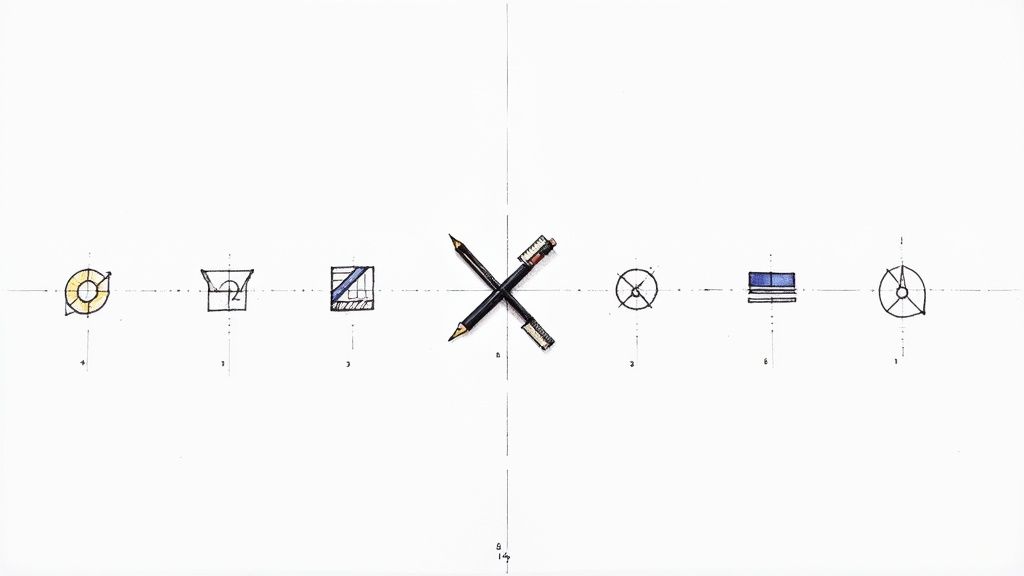
In the world of visual communication, certain ideas are so fundamental they've been distilled into memorable graphic design phrases. These aren't just trendy quotes for your mood board; they are the distilled wisdom of design masters, acting as guiding principles for creating work that is clear, effective, and resonant. Understanding these core concepts is the difference between simply arranging elements on a page and telling a compelling visual story that connects with an audience.
This article unpacks seven of the most crucial phrases that every designer should know. We will explore not just what they mean, but how to strategically apply their principles to elevate your own design work. We'll move beyond the surface level to provide actionable insights, practical examples, and the context you need to master these foundational ideas. Whether you're a seasoned professional looking to refine your approach or just starting out, internalizing these concepts will sharpen your design intuition and transform your creative process from arbitrary to intentional. Prepare to see how simple statements can hold the key to powerful, purpose-driven design.
1. Less is More
One of the most enduring and powerful graphic design phrases, "Less is more" champions simplicity, clarity, and purpose. Popularized by architect Ludwig Mies van der Rohe, this principle suggests that by removing superfluous elements, a design's core message becomes stronger and more impactful. It's not about emptiness, but about intention, where every element must justify its existence.
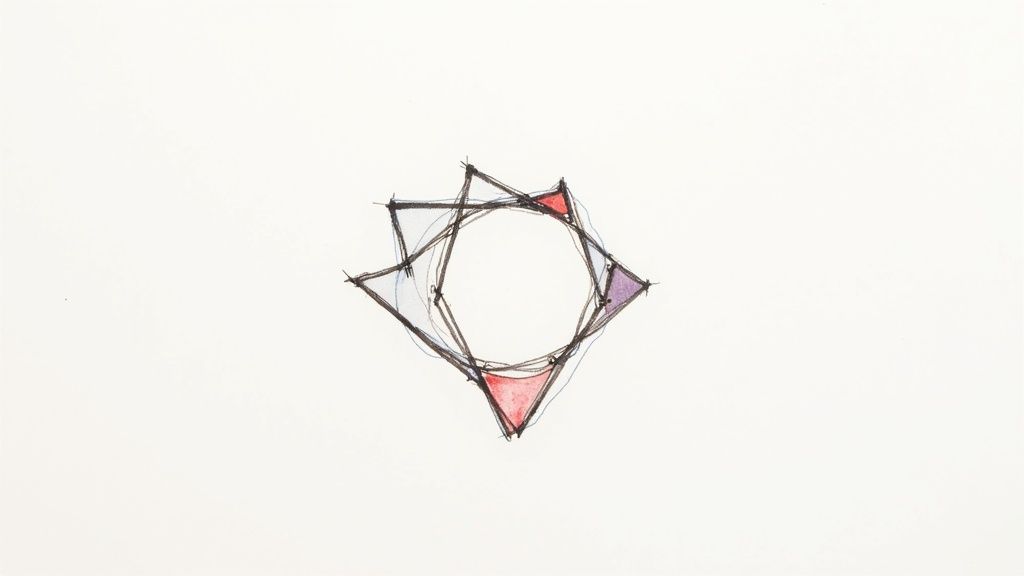
This philosophy is about achieving maximum effect with minimum means. By embracing strategic restraint, you allow essential content to shine, guiding the user's focus without distraction.
Key Insight: Minimalism isn't the absence of something; it's the perfect amount of everything.
Why It Works
A minimalist approach enhances usability and aesthetic appeal. Designs that are clean and uncluttered are easier to navigate and quicker to understand, reducing cognitive load on the viewer. For example, Google's search page is the epitome of this principle; its sparse interface focuses entirely on its primary function, delivering a seamless user experience. Similarly, Apple’s product packaging uses vast white space and simple typography to convey a sense of premium quality and sophistication before the box is even opened.
How to Implement "Less is More"
Applying this concept requires discipline and a critical eye. It's a process of subtraction, not addition.
- Start Big, Then Edit: Begin your design process with all the potential elements on the canvas. Then, critically evaluate each one and ask, "Does this serve a vital purpose?" If the answer is no, remove it.
- Embrace White Space: Use generous negative space (or "white space") to create breathing room around elements. This separates and defines sections, improves legibility, and creates a calm, organized feeling.
- Limit Your Palette: Stick to a restrained color scheme of two to three main colors. This creates a cohesive and professional look while using color more intentionally to highlight key information.
- Choose Functional Typography: Select typefaces for their readability and function, not just their decorative qualities. A clean, well-chosen font hierarchy is often more effective than multiple ornate styles.
By mastering the "Less is more" philosophy, you can create designs that are not only beautiful but also clear, effective, and timeless. This is one of those graphic design phrases that transcends trends, focusing on the fundamental goal of effective communication.
2. Form Follows Function
A cornerstone of modern design theory, "Form follows function" is a principle asserting that an object's aesthetic should be dictated by its purpose. Coined by architect Louis Sullivan and championed by the Bauhaus school, this phrase reminds us that in graphic design, visual choices must serve the core communication goal. It's about prioritizing usability and clarity over purely decorative flourishes, ensuring every element has a reason to exist.
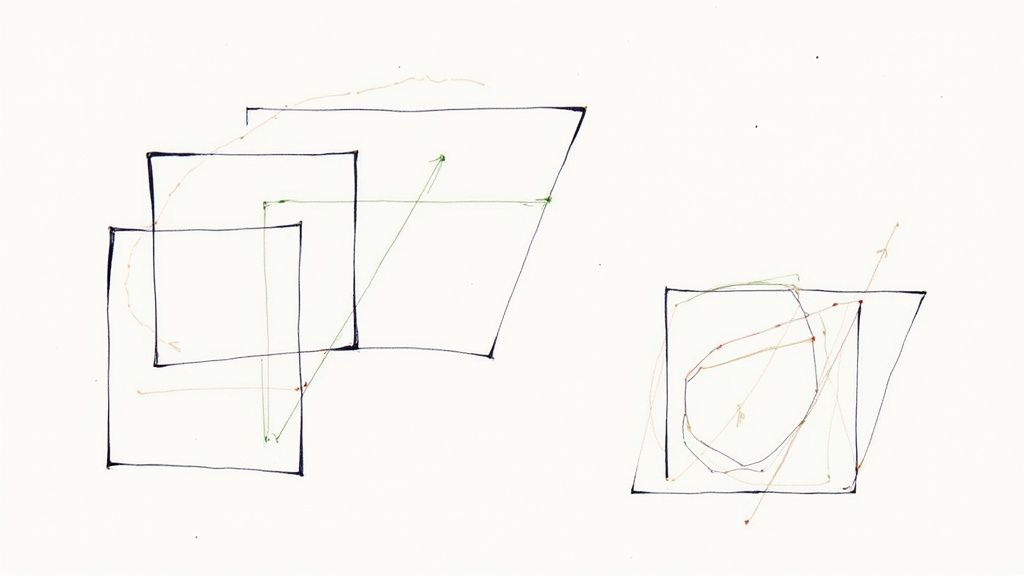
This approach ensures that design decisions are rooted in strategy, not just style. When the primary function guides the visual form, the resulting design is inherently more intuitive, effective, and user-friendly.
Key Insight: Great design isn't just about how it looks; it's about how it works.
Why It Works
Function-driven design creates experiences that are effortless for the user. Think of road signs: their simple, high-contrast typography and universally understood symbols are designed for one function: immediate legibility at a distance. Aesthetics are secondary to this purpose. Similarly, an e-commerce website with a clear "Add to Cart" button and intuitive navigation succeeds because its form supports its primary function of selling products. This principle is fundamental to creating designs that solve problems effectively. You can discover more about the impact of these core design principles and how they shape user experiences.
How to Implement "Form Follows Function"
Adopting this mindset means starting with "why" before moving to "what."
- Define the Primary Goal: Before you choose a single color or font, clearly articulate the design's main objective. Is it to inform, persuade, or enable a transaction? Let that goal be your guide.
- Prioritize a Clear Hierarchy: Organize information based on importance. The most critical elements, like a headline or a call-to-action, should be the most visually prominent.
- Question Every Element: For each icon, line, or image you add, ask yourself, "What function does this serve?" If it doesn’t support the primary goal, it may be a distraction.
- Test for Usability: The ultimate test of function is whether a real person can use your design easily. Conduct user testing to see if the form truly supports the intended function.
By making "Form follows function" a central part of your process, you build a foundation for designs that are not only beautiful but also powerful and purposeful. This is one of the most practical graphic design phrases for creating work that truly connects with and serves its audience.
3. White Space is Not Empty Space
A foundational concept in visual communication, "White space is not empty space" teaches designers to view blank areas as active, powerful components of a composition. Often called negative space, it's the intentional breathing room around elements on a page. Far from being a void to be filled, white space is a tool that enhances readability, creates focus, and adds a sense of elegance and sophistication.
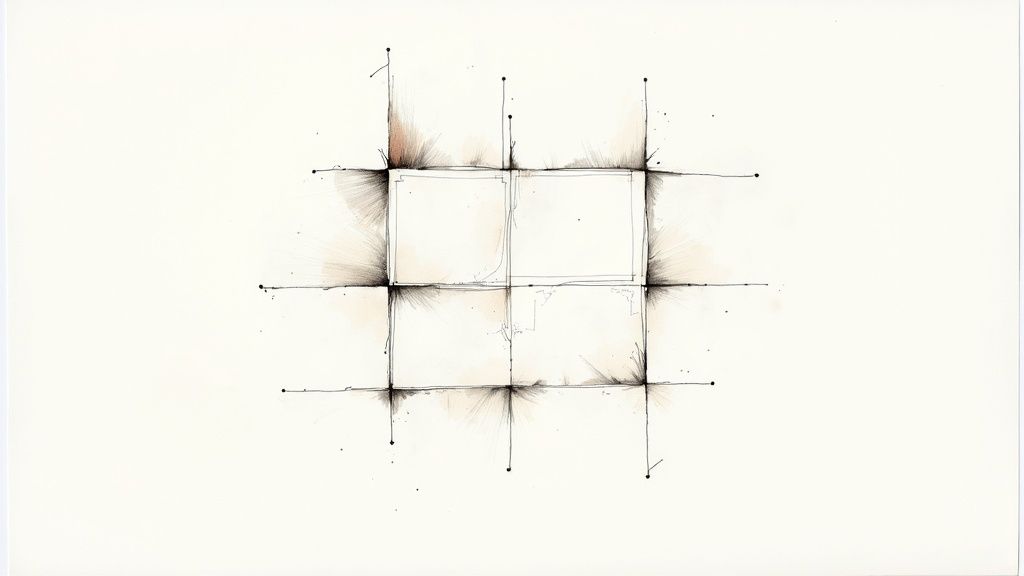
Pioneers like Jan Tschichold and Josef Müller-Brockmann championed this idea, understanding that the space between elements is just as important as the elements themselves. It guides the viewer's eye, establishes hierarchy, and can dramatically improve comprehension by reducing visual clutter.
Key Insight: Treat white space as an element, not an absence. It shapes, defines, and gives power to everything else in your design.
Why It Works
Properly utilized white space reduces cognitive load, making information easier to process and absorb. Think of luxury brand advertisements; they often feature a single product surrounded by vast negative space, which communicates exclusivity and focuses all attention on the item. Similarly, magazine layouts with generous margins feel more premium and are less intimidating to read than a dense wall of text. By giving content room to breathe, you make it more approachable and impactful.
How to Implement "White Space is Not Empty Space"
Mastering negative space is about balance and intention. It requires a conscious effort to resist filling every corner of the canvas.
- Group and Separate: Use proximity and white space to group related items together. The space between groups will create clear visual separation, organizing your content logically without needing lines or boxes.
- Create Visual Rhythm: Vary the amount of white space to establish a visual rhythm and hierarchy. More space around an element, like a website header or a call-to-action button, naturally draws the eye and signals its importance.
- Prioritize Margins and Padding: Don't crowd your content to the edges of its container. Generous margins and padding create a clean, professional frame for your design, improving legibility and aesthetic appeal.
- Think in Grids: Use a grid system to structure your layout. This helps you distribute white space more deliberately, ensuring a balanced and harmonious composition.
This is one of the most vital graphic design phrases to internalize. By viewing white space as a strategic tool, you can transform cluttered, confusing layouts into clear, compelling, and effective designs.
4. Content is King
While designers often focus on visual appeal, the phrase "Content is King" serves as a crucial reminder that design's primary role is to serve information. Popularized in the digital age by Bill Gates, this principle argues that the quality, relevance, and value of the content should dictate design choices. In graphic design, this means that every visual element, from typography to color, must enhance and clarify the message, not overshadow it.
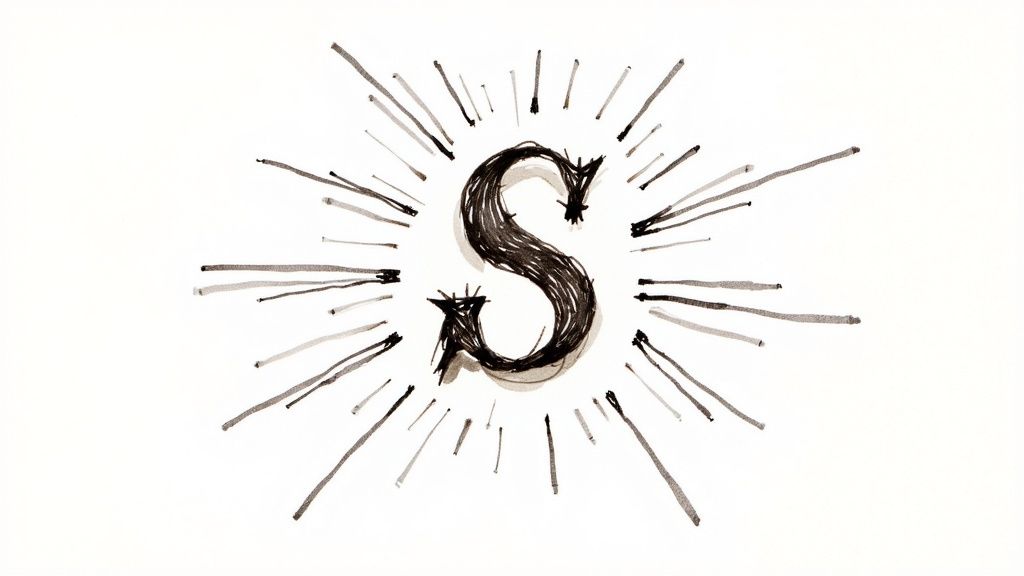
This philosophy positions the designer as a strategic communicator, not just a decorator. The goal is to make content accessible, understandable, and engaging, ensuring that the design acts as a seamless bridge between the message and the audience.
Key Insight: Great design makes great content unforgettable; it doesn't try to substitute for it.
Why It Works
A content-first approach ensures that the design has a clear purpose. When the message is the priority, the final product is more effective at informing, persuading, or educating the viewer. For instance, an annual report's design must prioritize clear data visualization and legible text to make complex financial information digestible. Similarly, a news website with a content-first layout uses a strong grid and typography to help readers quickly scan headlines and find articles, serving their primary need for information efficiently.
How to Implement "Content is King"
Adopting a content-first mindset means shifting your design process to begin with the message.
- Understand the Content First: Before you even open a design tool, read and fully understand all the content. Identify the key messages, the target audience, and the desired outcome.
- Design the Hierarchy: Use the content's importance to build your visual hierarchy. The most critical information should be the most prominent, using size, color, and placement to guide the user's eye.
- Choose Purposeful Visuals: Select typography, imagery, and colors that support the content's tone and meaning. A technical manual, for example, requires clean, highly readable fonts, not decorative scripts.
- Test for Comprehension: Show your designs to users and ask them what they learned or what the main takeaway was. If they can't easily understand the message, the design has failed, no matter how beautiful it is.
By making "Content is King" a core part of your process, you create designs that are not just aesthetically pleasing but also profoundly effective, making it one of the most vital graphic design phrases for communicators.
5. Typography is the Voice of Design
This powerful phrase emphasizes that typography does far more than just present words; it gives them a soul and an emotional tone. The typeface, its weight, spacing, and arrangement all combine to create a distinct personality that can be friendly, serious, elegant, or urgent. It’s the visual equivalent of a speaker's tone of voice, conveying feeling and intention before a single word is even read.
Typography doesn't just display information; it communicates how that information should be felt and interpreted. It can build trust, evoke nostalgia, or create excitement, making it a fundamental tool for shaping audience perception.
Key Insight: Words deliver the message, but typography delivers the feeling.
Why It Works
The choice of typeface profoundly impacts how a brand or message is perceived. For example, Coca-Cola's classic script font evokes a sense of tradition, happiness, and warmth that a standard sans-serif could never achieve. Conversely, the clean, modern sans-serif used in the FedEx logo communicates efficiency and reliability. Horror movie posters often use distressed, sharp fonts to create a sense of unease, while a children's book might use playful, rounded letterforms to feel welcoming and fun. These choices are intentional, aligning the visual tone with the core message.
How to Implement "Typography is the Voice of Design"
Treating typography as a voice requires careful selection and strategic application.
- Match Typeface to Tone: Select fonts whose personalities align with your brand's message. A luxury brand might use an elegant serif, while a tech startup may opt for a clean, futuristic sans-serif.
- Limit Your Combinations: Stick to two or three complementary fonts to create a clear hierarchy and maintain visual coherence. Too many "voices" can lead to a chaotic and confusing design.
- Prioritize Readability: Ensure your chosen typeface is legible across all sizes and mediums, from a tiny mobile screen to a large billboard. A voice that can't be understood is ineffective.
- Understand Context: Study the historical and cultural associations of a typeface. A font can carry decades of meaning that will subconsciously influence your audience. For a more detailed look, you can explore this typography guide on vibe-icons.com.
By mastering this concept, one of the most crucial graphic design phrases, you can ensure your designs speak to your audience in the right tone, building a stronger and more authentic connection.
6. Good Design is Good Business
A foundational principle for any creative professional, "Good design is good business" elevates design from a mere aesthetic exercise to a core strategic asset. Coined by former IBM CEO Thomas J. Watson Jr., this phrase argues that thoughtful, user-centric design is not a cost but a powerful investment that drives tangible business outcomes. It repositions design as a critical component for building brand credibility, enhancing user experience, and creating a competitive advantage.
This philosophy treats design as a problem-solving tool that directly impacts customer loyalty, market differentiation, and profitability. When design is aligned with business objectives, it creates products and experiences that people not only use but love.
Key Insight: Design is not just what it looks and feels like. Design is how it works for the business and the user.
Why It Works
Effective design directly translates into measurable success. Apple’s entire empire is built on this principle; its intuitive interfaces and elegant product design justify a premium price point and cultivate intense brand loyalty. Similarly, Airbnb's thoughtful rebranding and user-friendly platform overhaul led to a massive increase in bookings and user trust, demonstrating how design can build an entire market. A well-designed product, like the collaboration tool Slack, can drive rapid adoption simply because its user-friendly interface makes work easier and more pleasant.
How to Implement "Good Design is Good Business"
Integrating this mindset requires a strategic, data-informed approach that connects creative work to business goals.
- Align Design with Business Objectives: Before starting any project, ask, "What business goal does this design support?" Whether it's increasing conversion rates, improving user retention, or building brand awareness, every design decision should have a clear purpose.
- Track Design-Related Metrics: Use analytics to measure the impact of your design choices. Track metrics like conversion rates, user engagement time, task completion rates, and customer satisfaction scores to demonstrate ROI.
- Invest in User Research: Don't guess what users want. Conduct user research, A/B testing, and usability studies to gather real-world data. This ensures your design solutions are solving actual user problems effectively.
- Build a Consistent Design System: Develop a comprehensive design system to maintain brand consistency across all touchpoints. This not only improves user experience but also increases internal efficiency, saving time and resources in the long run.
Adopting this phrase means moving beyond aesthetics and becoming a strategic partner in an organization's success. It’s one of the most vital graphic design phrases for proving the value and impact of creative work.
7. Consistency Creates Trust
This fundamental graphic design phrase highlights the direct link between a coherent visual identity and audience confidence. "Consistency creates trust" is the principle that when a brand presents itself uniformly across all touchpoints, it appears more professional, reliable, and memorable. This coherence in colors, typography, imagery, and messaging builds a predictable and reassuring experience for the user.
When an audience encounters the same visual language repeatedly, it fosters familiarity and reinforces brand identity. This predictability eliminates confusion and signals that the brand is stable and dependable, which is crucial for building long-term loyalty.
Key Insight: Consistency isn't about being repetitive; it's about being reliable and instantly recognizable.
Why It Works
A consistent design system strengthens brand recognition and builds equity. When every interaction feels familiar, users don’t have to re-learn how to engage with your brand on different platforms. For example, McDonald's golden arches and red-and-yellow color scheme are instantly recognizable worldwide, creating a sense of familiarity whether you're in Tokyo or Toronto. Similarly, Google’s Material Design system ensures that its vast suite of products, from Gmail to Google Maps, feel like part of a unified, intuitive ecosystem, which makes users feel secure and confident in the platform.
How to Implement "Consistency Creates Trust"
Achieving brand consistency requires a systematic and deliberate approach that goes beyond just using the same logo everywhere.
- Develop a Style Guide: Create a comprehensive brand guidelines document. This should detail logo usage, color palettes, typography rules, voice and tone, and imagery standards to serve as a single source of truth.
- Use Design Systems: For digital products, build a library of reusable components and patterns. This ensures that buttons, forms, and navigation elements look and behave the same across your entire application or website.
- Conduct Regular Audits: Periodically review all your brand assets, from social media profiles to marketing materials, to identify and correct any inconsistencies. This maintains the integrity of your visual identity over time.
- Train Your Team: Ensure everyone creating content for your brand, from marketers to developers, understands and has access to the brand guidelines. You can learn more about how to build a trustworthy brand on vibe-icons.com.
By prioritizing consistency, you transform your design from a collection of separate assets into a powerful, unified brand experience that builds lasting trust with your audience.
Key Principles Comparison of 7 Graphic Design Phrases
| Principle | Implementation Complexity 🔄 | Resource Requirements ⚡ | Expected Outcomes 📊 | Ideal Use Cases 💡 | Key Advantages ⭐ |
|---|---|---|---|---|---|
| Less is More | Moderate - achieving meaningful simplicity can be challenging | Low to Moderate - fewer elements reduces production time and costs | Increased readability, timeless designs, faster digital load times | Minimalist branding, clean interfaces, elegant product design | Clear communication, strong brand recognition, visual clarity |
| Form Follows Function | Moderate to High - requires thorough functional analysis | Moderate - user testing and purposeful design needed | Enhanced usability, efficient communication, sustainable solutions | Wayfinding, instructional materials, user-centered interfaces | Improved user experience, cost-effective, functional clarity |
| White Space is Not Empty Space | Moderate - skill needed to balance space and content | Low to Moderate - focuses on layout and spacing | Increased readability, visual emphasis, reduced cognitive load | Luxury branding, editorial layouts, clean digital interfaces | Sophisticated appearance, better focus, improved scanning |
| Content is King | Moderate - requires deep content understanding | Moderate - involves content analysis and audience research | Effective message delivery, higher engagement and retention | Data-driven reports, educational materials, content-heavy sites | Strong communication, audience focus, long-term relevance |
| Typography is the Voice of Design | High - specialized knowledge of type and tone required | Moderate to High - requires typographic expertise and testing | Emotional connection, clear brand personality, stronger impact | Branding, advertising, editorial design, emotional storytelling | Enhanced brand voice, readability, visual memorability |
| Good Design is Good Business | High - strategic alignment with business goals needed | High - investment in research, testing and design systems | Measurable business impact, increased trust and market advantage | Corporate branding, product design, UX-driven business models | ROI-focused, competitive advantage, credibility |
| Consistency Creates Trust | Moderate - needs planning and system implementation | Moderate to High - requires brand guidelines and audits | Strong brand recognition, increased trust, consistent professionalism | Global brands, multi-channel marketing, design system setups | Cohesive brand identity, efficient production, audience trust |
From Theory to Practice: Integrating These Principles into Your Workflow
We’ve explored seven foundational graphic design phrases that serve as guiding principles for creating compelling and effective visual work. Moving beyond mere buzzwords, these concepts represent a strategic toolkit for every designer. From the minimalist ethos of "Less is More" to the business-centric truth that "Good Design is Good Business," each phrase offers a lens through which to evaluate, refine, and elevate your creative output.
True mastery comes not from memorizing these sayings, but from internalizing their meaning and weaving them into the fabric of your daily workflow. Think of them as a constant, internal dialogue. When laying out a page, ask yourself: "Is this white space intentional, or just empty?" When selecting a typeface, consider: "What is the voice of this design, and does the typography reflect it?" This shift from a reactive to a proactive mindset is what separates competent designers from truly exceptional ones.
Making These Principles Actionable
Integrating these ideas requires a conscious effort to build better creative habits. The goal is to make these principles second nature, allowing you to solve problems more intuitively and efficiently.
Here are some practical next steps to transform these phrases from abstract theory into concrete practice:
- Conduct a 'Less is More' Audit: Review one of your recent projects. Identify and remove one element that is not absolutely essential to the design's core message or function. Observe how this subtraction impacts the overall clarity and focus.
- Prioritize Function First: On your next project, start by wireframing the user flow or information hierarchy before considering any colors, fonts, or imagery. This forces you to nail the "Form Follows Function" principle from the outset.
- Embrace Consistency Audits: Regularly check your projects for visual consistency. Do your button styles, icons, and color palettes remain uniform across all screens and assets? A simple checklist can help build this habit, directly reinforcing how "Consistency Creates Trust."
The Lasting Impact of Foundational Wisdom
Ultimately, these graphic design phrases are not restrictive rules but liberating frameworks. They provide a common language for discussing and defending design decisions with clients, stakeholders, and team members. They empower you to create work that is not just aesthetically pleasing but also purposeful, user-centric, and strategically aligned with business objectives.
By consistently applying these principles, you move beyond simply arranging pixels on a screen. You become a strategic problem-solver, a visual storyteller, and an architect of user experiences. The designs you produce will be smarter, more resonant, and significantly more effective, solidifying your value and impact as a creative professional.
Struggling to maintain visual consistency, especially with your icon sets? VibeIcons can help. Generate custom, AI-powered icons that perfectly match the style of popular libraries like Heroicons or Lucide, ensuring your designs always feel cohesive and professional. Explore the possibilities at VibeIcons.